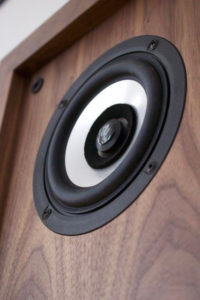What is a full-range driver?
More accurately termed a wide bandwidth (or wideband) driver, a term we prefer, it is a single loudspeaker drive unit which covers the majority of the audible spectrum. The frequency range of a human ear is usually defined as 20 to 20,000 Hz. No single driver can encompass this range but a well-designed driver such as the Eikona can get very close. Our founder, Ted Jordan, had 60 years of experience working with wideband drivers and was a passionate advocate of their advantages.
Why do you use a single drive unit rather than separate woofers and tweeters?
Crossover circuits subdivide the audio spectrum into sharply-defined segments within the frequency range, usually in the area where the ear is most critical, around 1 kHz to 3 kHz. These are then radiated from spatially-separated drivers of diverse sonic and distribution characteristics. To achieve the seamless reintegration of musical fundamentals and their upper harmonics throughout the listening area is outside the laws of physics. With a single, full-range drive unit the entire sonic structure can be radiated from the same source.
Why does the Eikona have a metal cone rather than paper or plastic?
The performance of a loudspeaker from the midband upwards is largely governed by the flexural waves travelling from the voice coil to the surround. Flexing involves alternate displacement and restoration of a material about its normal state. In order to preserve low level detail, this flexing needs to have a fast and linear response to the driving forces from the voice coil. This requires true elasticity as defined by Hooke’s Law. This is a characteristic of materials having crystalline structures where the elasticity is due to intermolecular forces.
The light metal alloys are the optimal practical choice for this. Paper and synthetic materials are elastomeric – they depend upon the folding and unfolding of long molecular chains for their elasticity, a non-linear and relatively slow process.
Sound quality is subjective and loudspeaker design is a compromise – factoring bandwidth, response consistency, transient performance, distortion and impedance parameters. Most of these characteristics are interrelated and you cannot change one without affecting many of the others. The Jordan approach has always been to use the most appropriate materials and work with the laws of physics.
This is not a matter of fashion. We pioneered the use of full-range metal cone drive units in 1964 with the release of the Jordan-Watts Module. Our Controflex™ cone is continuously improved and we feel that our developments continue to lead the field.
Why do you use a 100 mm diameter cone?
It is the ideal compromise of a number of factors, including bass and treble extension, moving mass, transient response, and frequency response. Balancing these gives us the 100 mm cone size. The Eikona has an exceptionally smooth response which extends to beyond audibility for the vast majority of listeners. It is enough to get the full atmosphere and texture of acoustic and orchestral music.
Are there any advantages to using more than one Eikona per enclosure?
Assuming the drivers are identical and have a nominally flat frequency response, then due to the characteristics of the radiation curve, the use of two or more such drivers will increase the efficiency of the bass and mid-band frequencies relative to the upper frequencies. The transition frequency and distribution pattern will depend upon the layout geometry of the drivers. We have looked at this in more detail in our Audio Building Blocks series in our blog.
Will the Eikona work with low-power amplifiers, such as tube amps?
The Eikona works remarkably well with tube amplifiers and lower-power class A amplifiers. The lack of crossover means that the impedance curve is substantially level.
Will the performance of your drive units be improved if I coat the cones with Audio Supergunk ™?
If it would, we would have already done it. Coating the cone with damping material or magic dots may alter the mass, affect damping and quite possibly glue up the works. It will certainly alter the carefully balanced design of the Eikona and will invalidate the guarantee.
Are there any other Jordan drive units available?
The Eikona is the only drive unit in current production which is designed, tested and approved by EJ Jordan Ltd.


